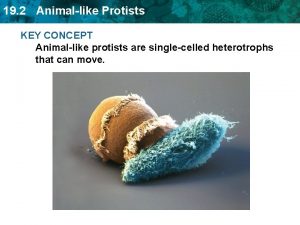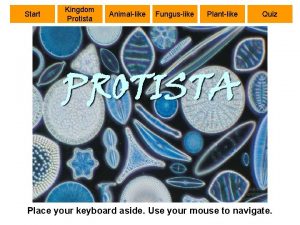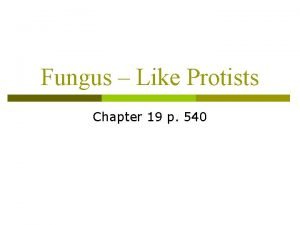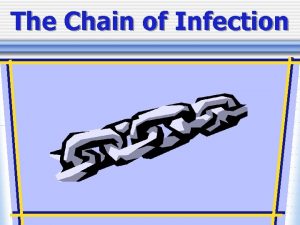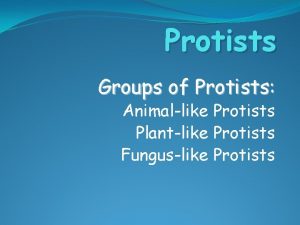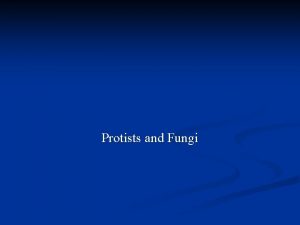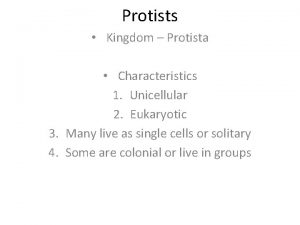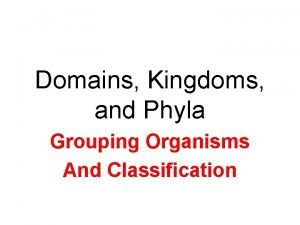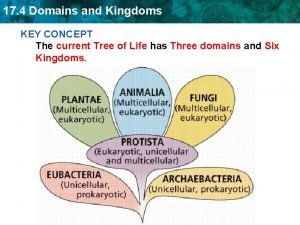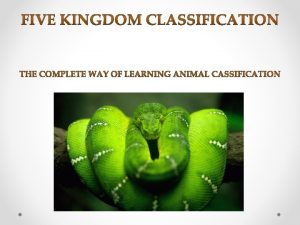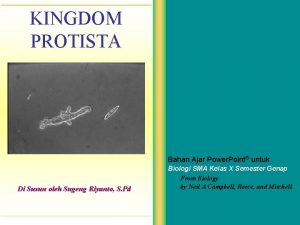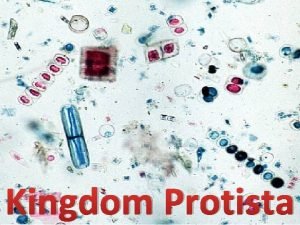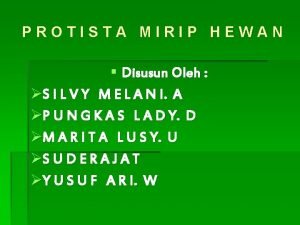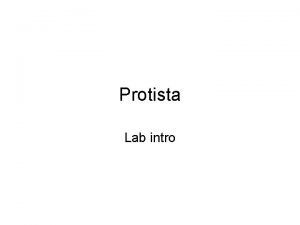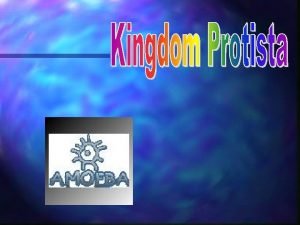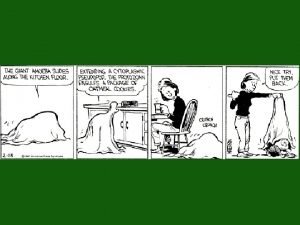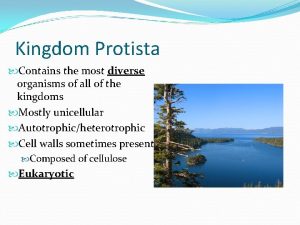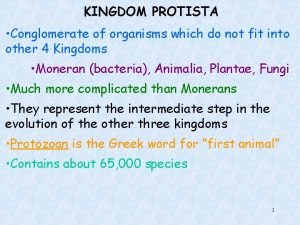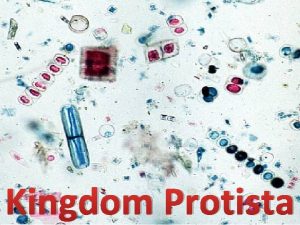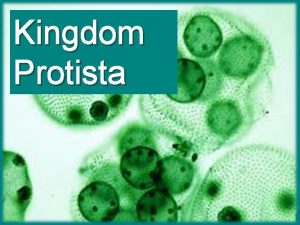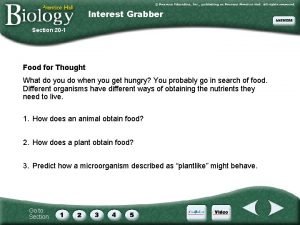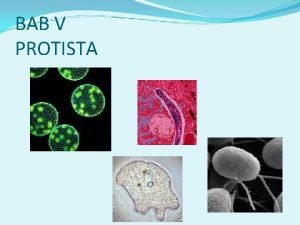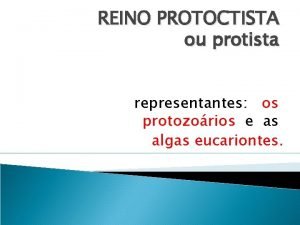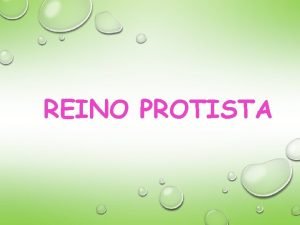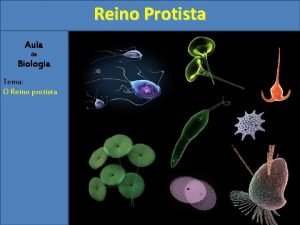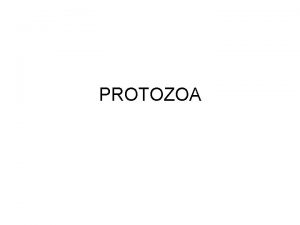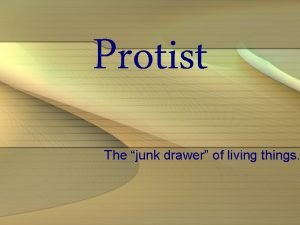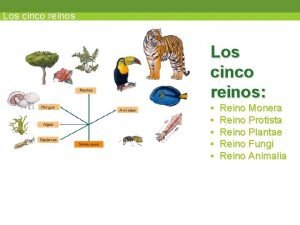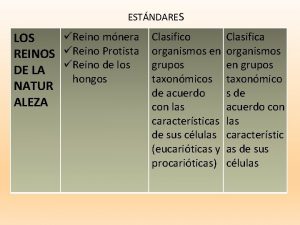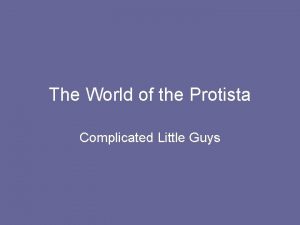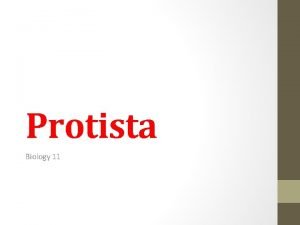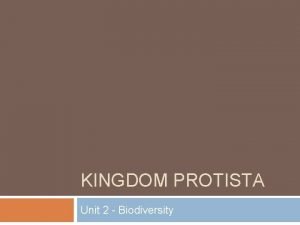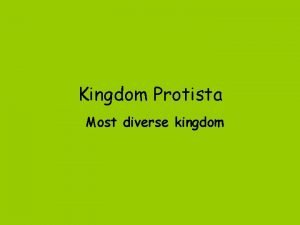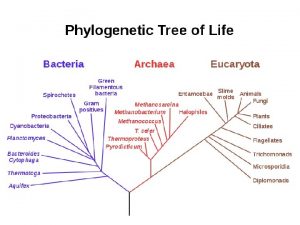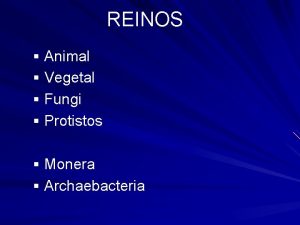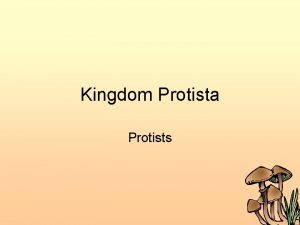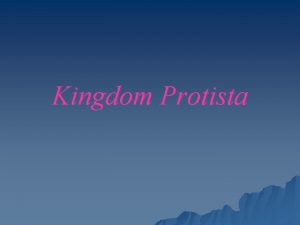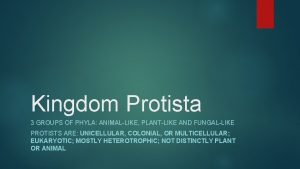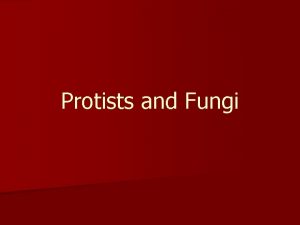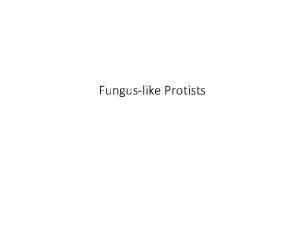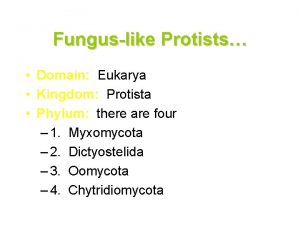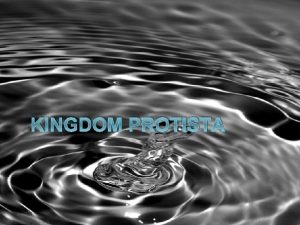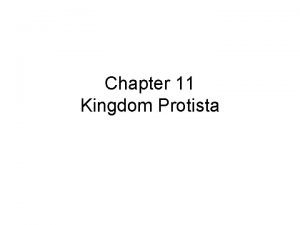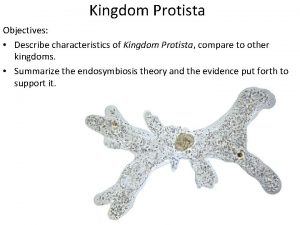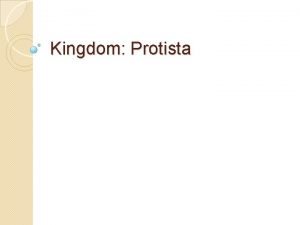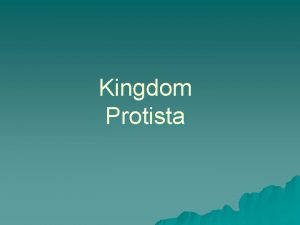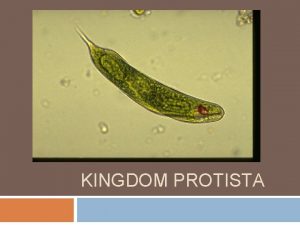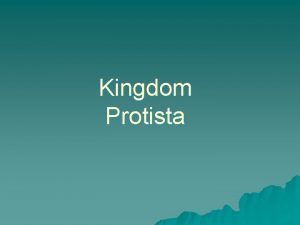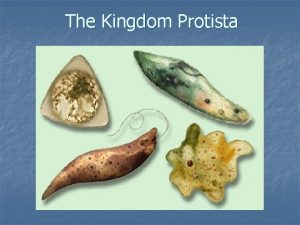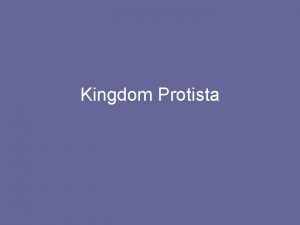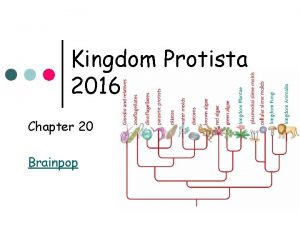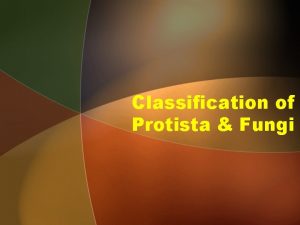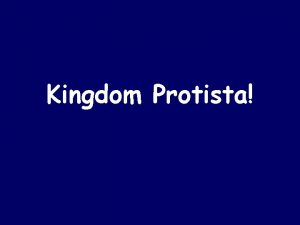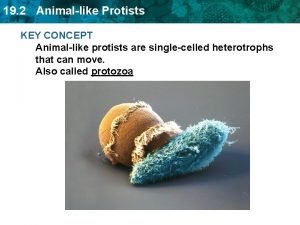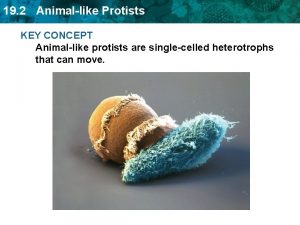Start Kingdom Protista Animallike Funguslike Plantlike Quiz Place





























































- Slides: 61

Start Kingdom Protista Animal-like Fungus-like Plant-like Quiz Place your keyboard aside. Use your mouse to navigate.

back Microorganisms Like their name implies, microorganisms such as Protista and bacteria are microscopic and can only be seen with the help of a microscope. Despite their small size, they have a large impact on nature. home

back Microorganisms Like their name implies, microorganisms such as Protista and bacteria are microscopic and can only be seen with the help of a microscope. Despite their small size, they have a large impact on nature. Since they are unicellular, their single cell must be able to perform all the necessary processes required to survive. This includes the ability to create or obtain energy, reproduce, and escape from predators. home

back Microorganisms Like their name implies, microorganisms such as Protista and bacteria are microscopic and can only be seen with the help of a microscope. Despite their small size, they have a large impact on nature. Since they are unicellular, their single cell must be able to perform all the necessary processes required to survive. This includes the ability to create or obtain energy, reproduce, and escape from predators. Bacteria are the simplest forms of life on Earth. We know this because they have the simplest cell structure. Bacteria are prokaryotes, which means they lack a nucleus and other membrane-bound organelles such as mitochondria, rough ER, and vacuoles. According to fossil evidence, bacteria are thought to be about 3. 5 billion years old. home

back Kingdom Protista Scientists are not quite sure how some bacteria evolved into the first protista, but fossil evidence dates protista to around 1. 5 billion years ago. Members of Kingdom Protista are all eukaryotic (they have a true nucleus) and need some kind of a water-based environment (freshwater, marine water, snow, damp soil) in which to live. All are aerobic (require oxygen) and have mitochondria to do cellular respiration. home

back Kingdom Protista Scientists are not quite sure how some bacteria evolved into the first protista, but fossil evidence dates protista to around 1. 5 billion years ago. Members of Kingdom Protista are all eukaryotic (they have a true nucleus) and need some kind of a water-based environment (freshwater, marine water, snow, damp soil) in which to live. All are aerobic (require oxygen) and have mitochondria to do cellular respiration. Currently, there approximately 60, 000 known species. Protista are incredibly diverse and actually have few traits in common with other Protista. For example… home

back Protista Differences Most members of Kingdom Protista are unicellular, others are colonial, and yet others are multicellular. Single celled Euglena Colonial Volvox home Multicellular Kelp

back Protista Differences Most members of Kingdom Protista are unicellular, others are colonial, and yet others are multicellular. Some are autotrophic and have chloroplasts in which to perform photosynthesis, but many are heterotrophic and feed on others. Photosynthetic algae Heterotrophic Paramecium home

back Protista Differences Most members of Kingdom Protista are unicellular, others are colonial, and yet others are multicellular. Some are autotrophic and have chloroplasts in which to perform photosynthesis, but many are heterotrophic and feed on others. Protists are grouped into three major, categories based on how they obtain nutrition. They are divided into: protozoans (animal-like), algae (plant-like), and slime molds (fungus-like). home This animal-like Amoeba is swallowing its prey.

back Protista Differences Most members of Kingdom Protista are unicellular, others are colonial, and yet others are multicellular. Some are autotrophic and have chloroplasts in which to perform photosynthesis, but many are heterotrophic and feed on others. Protists are grouped into three major, categories based on how they obtain nutrition. They are divided into: protozoans (animal-like), algae (plant-like), and slime molds (fungus-like). Plant-like protista do photosynthesis. home

back Protista Differences Most members of Kingdom Protista are unicellular, others are colonial, and yet others are multicellular. Some are autotrophic and have chloroplasts in which to perform photosynthesis, but many are heterotrophic and feed on others. Protists are grouped into three major, categories based on how they obtain nutrition. They are divided into: protozoans (animal-like), algae (plant-like), and slime molds (fungus-like). home Here is a fungus-like protista called “dog vomit slime mold” because it resembles…you get the idea I hope.

Quick Stop #1 back home Which is generally true about Protista? Protista are usually No. Some protista are multicellular, but most multicellular are unicellular. __________. correct unicellular prokaryotes correct eukaryotes Protista are always __________. No. Bacteria are the only prokaryotes.

back Protozoans Animal-like protists are called protozoans ("first animals") because it is thought that they are the ancestors to animals. They share many common traits with animals. All of the animal-like protists are heterotrophs; they are unable to make their own food. But unlike animals, they are unicellular. Since they can’t make their own food they must be able to move through their environment and catch their food. home Animals are multicellular Protozoans are unicellular

back Protozoans Animal-like protists are called protozoans ("first animals") because it is thought that they are the ancestors to animals. They share many common traits with animals. All of the animal-like protists are heterotrophs; they are unable to make their own food. But unlike animals, they are unicellular. Since they can’t make their own food they must be able to move through their environment and catch their food. Protozoans are divided into groups based upon their means of mobility and manners for catching their food. They are divided into: protists with pseudopods, protists with cilia, and protists with flagella. home

back Pseudopods A pseudopod is a "false foot" that slowly moves the protist. These protists move towards their food or prey by extending their cytoplasm. home

back Pseudopods A pseudopod is a "false foot" that slowly moves the protist. These protists move towards their food or prey by extending their cytoplasm. The pseudopod extends from the cytoplasm, attaches to the ground, and pulls the rest of the body toward the food. home

back Pseudopods A pseudopod is a "false foot" that slowly moves the protist. These protists move towards their food or prey by extending their cytoplasm. The pseudopod extends from the cytoplasm, attaches to the ground, and pulls the rest of the body toward the food. The pseudopods are not only for the means of locomotion; they also capture food by wrapping the "false foot" around their prey and bringing it into their bodies. One example of an animal-like protist with pseudopods is the Amoeba. home Pseudopod extending around prey

back Pseudopods A pseudopod is a "false foot" that slowly moves the protist. These protists move towards their food or prey by extending their cytoplasm. The pseudopod extends from the cytoplasm, attaches to the ground, and pulls the rest of the body toward the food. The pseudopods are not only for the means of locomotion; they also capture food by wrapping the "false foot" around their prey and bringing it into their bodies. One example of an animal-like protist with pseudopods is the Amoeba. Pseudopod has the prey trapped home

back Amoebas are single celled animal-like protists that live in moist soil, freshwater, and salt water. There are different types of Amoeba but they all use pseudopods as means of locomotion and capturing food. Most of the Amoebas are free-living and eat things like other protozoans and bacteria, but a few Amoebas are parasitic. home

back Amoebas are single celled animal-like protists that live in moist soil, freshwater, and salt water. There are different types of Amoeba but they all use pseudopods as means of locomotion and capturing food. Most of the Amoebas are free-living and eat things like other protozoans and bacteria, but a few Amoebas are parasitic. An example of a parasitic Amoeba is Entamoeba histolytica. This Amoeba is the cause of amoebic dysentery, which is a deadly infectious disease found mostly in tropical areas and in areas where sanitation is poor. This disease is a leading cause of death for infants and toddlers since their immune systems are not yet developed. home

back Amoebas are single celled animal-like protists that live in moist soil, freshwater, and salt water. There are different types of Amoeba but they all use pseudopods as means of locomotion and capturing food. Most of the Amoebas are free-living and eat things like other protozoans and bacteria, but a few Amoebas are parasitic. An example of a parasitic Amoeba is Entamoeba histolytica. This Amoeba is the cause of amoebic dysentery, which is a deadly infectious disease found mostly in tropical areas and in areas where sanitation is poor. This disease is a leading cause of death for infants and toddlers since their immune systems are not yet developed. home

back Ciliates home Cilia are tiny hair-like structures that surround some protists. The cilia beat back and forth. This movement enables the animal-like protist to move through its aquatic environment. The cilia also help the organism capture food. When the cilia beat, the prey (food) is moved into its body. Beating cilia create currents that draw food into this ciliates mouth

back Ciliates Cilia are tiny hair-like structures that surround some protists. The cilia beat back and forth. This movement enables the animal-like protist to move through its aquatic environment. The cilia also help the organism capture food. When the cilia beat, the prey (food) is moved into its body. The cilia can also help the protist move towards the food/prey by propelling the organism through their aquatic environment. home

back Ciliates Cilia are tiny hair-like structures that surround some protists. The cilia beat back and forth. This movement enables the animal-like protist to move through its aquatic environment. The cilia also help the organism capture food. When the cilia beat, the prey (food) is moved into its body. The cilia can also help the protist move towards the food/prey by propelling the organism through their aquatic environment. One example of an animal-like protist with cilia is the Paramecium. The cilia help the Paramecium push the food and water into the body of the cell. The food then becomes enclosed in a vesicle filled with digestive enzymes. home

back Flagellates home Flagella are long whip-like structures that move back and forth allowing the animallike protist to move. Protists with flagella beat the long whip-like structure to move through their aquatic environments. These organisms can be free-living although some are parasitic, living in moist tissues of plants and animals. flagella

back Flagellates Flagella are long whip-like structures that move back and forth allowing the animallike protist to move. Protists with flagella beat the long whip-like structure to move through their aquatic environments. These organisms can be free-living although some are parasitic, living in moist tissues of plants and animals. One example of an animal-like protist with flagella is Giardia lamblia uses flagella as its means of locomotion and food capturing. It is an internal parasite the causes diarrhea. home

back Flagellates Flagella are long whip-like structures that move back and forth allowing the animallike protist to move. Protists with flagella beat the long whip-like structure to move through their aquatic environments. These organisms can be free-living although some are parasitic, living in moist tissues of plants and animals. One example of an animal-like protist with flagella is Giardia lamblia uses flagella as its means of locomotion and food capturing. It is an internal parasite the causes diarrhea. Giardia lamblia contaminates waters of aquatic lands and river banks. When animals and humans drink the water, the protist becomes parasitic to the host. It leaves the host through the feces. Many humans get this disease by drinking infected waters or eating infected meats. home

back Malaria Many protists are disease causing. When conditions are good for them they are active; when conditions are bad they become dormant. One example of this parasitic animal-like protist is Plasmodium, which causes malaria. home

back Malaria Many protists are disease causing. When conditions are good for them they are active; when conditions are bad they become dormant. One example of this parasitic animal-like protist is Plasmodium, which causes malaria. Plasmodium is a parasitic animal-like protist transported through mosquitoes. While in the mosquito the Plasmodium is in a dormant stage. When a mosquito bites a human, it is transported into the human where it becomes active. home Plasmodium Red blood cell

back Malaria Many protists are disease causing. When conditions are good for them they are active; when conditions are bad they become dormant. One example of this parasitic animal-like protist is Plasmodium, which causes malaria. Plasmodium is a parasitic animal-like protist transported through mosquitoes. While in the mosquito the Plasmodium is in a dormant stage. When a mosquito bites a human, it is transported into the human where it becomes active. The Plasmodium reproduces asexually inside the liver and then enters red blood cells, where they are destroyed in massive amounts. When a mosquito bites an infected person, the Plasmodium are taken into the mosquito and the process begins all over again. home Plasmodium injected into human when bitten by mosquito

back Malaria Many protists are disease causing. When conditions are good for them they are active; when conditions are bad they become dormant. One example of this parasitic animal-like protist is Plasmodium, which causes malaria. Plasmodium is a parasitic animal-like protist transported through mosquitoes. While in the mosquito the Plasmodium is in a dormant stage. When a mosquito bites a human, it is transported into the human where it becomes active. The Plasmodium reproduces asexually inside the liver and then enters red blood cells, where they are destroyed in massive amounts. When a mosquito bites an infected person, the Plasmodium are taken into the mosquito and the process begins all over again. home Plasmodium grow and develop inside the liver

back Malaria Many protists are disease causing. When conditions are good for them they are active; when conditions are bad they become dormant. One example of this parasitic animal-like protist is Plasmodium, which causes malaria. Plasmodium is a parasitic animal-like protist transported through mosquitoes. While in the mosquito the Plasmodium is in a dormant stage. When a mosquito bites a human, it is transported into the human where it becomes active. The Plasmodium reproduces asexually inside the liver and then enters red blood cells, where they are destroyed in massive amounts. When a mosquito bites an infected person, the Plasmodium are taken into the mosquito and the process begins all over again. home Normal red blood cell Infected red blood cell Plasmodium migrate into the blood stream and multiply inside red blood cells.

back Malaria Many protists are disease causing. When conditions are good for them they are active; when conditions are bad they become dormant. One example of this parasitic animal-like protist is Plasmodium, which causes malaria. Plasmodium is a parasitic animal-like protist transported through mosquitoes. While in the mosquito the Plasmodium is in a dormant stage. When a mosquito bites a human, it is transported into the human where it becomes active. The Plasmodium reproduces asexually inside the liver and then enters red blood cells, where they are destroyed in massive amounts. When a mosquito bites an infected person, the Plasmodium are taken into the mosquito and the process begins all over again. home Infected red blood cells burst, releasing more Plasmodium into the blood

back Malaria Many protists are disease causing. When conditions are good for them they are active; when conditions are bad they become dormant. One example of this parasitic animal-like protist is Plasmodium, which causes malaria. Plasmodium is a parasitic animal-like protist transported through mosquitoes. While in the mosquito the Plasmodium is in a dormant stage. When a mosquito bites a human, it is transported into the human where it becomes active. The Plasmodium reproduces asexually inside the liver and then enters red blood cells, where they are destroyed in massive amounts. When a mosquito bites an infected person, the Plasmodium are taken into the mosquito and the process begins all over again. home Mosquito bites infected person to restart the cycle

back Quick Stop #2 home correct protozoans prokaryotes Animal-like protista are called _________. correct Giardia Paramecia Drinking water contaminated with ___________ can lead to diarrhea and death. Amoeba do not have true legs. Instead they move by extending cilia flagella pseudopods their _____________. correct

back Fungus-Like Protista They are fungus-like in their nutrition in that they absorb nutrients from their environment. home

back Fungus-Like Protista They are fungus-like in their nutrition in that they absorb nutrients from their environment. One group are called “slime molds. ” Their “body” is unusual in that the nuclei undergo mitosis, but there is no cytokinesis, which means the cells never separate. Rather, the “body” is a giant mass of cytoplasm with many nuclei. home

back Fungus-Like Protista They are fungus-like in their nutrition in that they absorb nutrients from their environment. One group are called “slime molds. ” Their “body” is unusual in that the nuclei undergo mitosis, but there is no cytokinesis, which means the cells never separate. Rather, the “body” is a giant mass of cytoplasm with many nuclei. Slime molds are mobile: they move like a giant Amoeba with giant pseudopods. They live in decayed wood and move around in between the fibers, ingesting bacteria, etc. by phagocytosis. Slime molds are often brightly-colored (yellow or orange). home

back Historical Water Mold Water molds attack foods such as potatoes, cabbage, and corn. An example of the devastation a water mold is capable of doing happened between the years of 1845 and 1860. During this time, the potato growing seasons were cold and damp. These conditions encouraged the spread of the water mold Phytophthora infestans. home

back Historical Water Mold Water molds attack foods such as potatoes, cabbage, and corn. An example of the devastation a water mold is capable of doing happened between the years of 1845 and 1860. During this time, the potato growing seasons were cold and damp. These conditions encouraged the spread of the water mold Phytophthora infestans. This water mold infested the potato crops in Ireland caused the potato plants to rot. One third of Ireland’s population died by either starvation or were killed by the infested potatoes. This time period is known as the Irish Potato Famine. Memorial tribute in Dublin home

back Quick Stop #3 home correct heterotrophs autotrophs Fungus-like protista are _________. The Potato Famine was a deadly disease that took place in Scotland Ireland ___________. correct

back Plant-like Protista Plant-like protists are autotrophic; they can make their own foods. They live in soil, on the bark of trees, in fresh water, and in salt water. Plant-like protists are very important to the earth because they produce an abundant amount of oxygen. They are the basis for the aquatic food chain. home

back Plant-like Protista Plant-like protists are autotrophic; they can make their own foods. They live in soil, on the bark of trees, in fresh water, and in salt water. Plant-like protists are very important to the earth because they produce an abundant amount of oxygen. They are the basis for the aquatic food chain. These protists are similar to plants as they are photosynthetic. Some have stem-like structures called stipes and anchoring structures called holdfasts, while plants have actual stems and roots. Many of these protists release their eggs into the environment where the sperm will fertilize the egg. home This green algae is thought to be an ancestor of modern plants

back Euglena are plant-like protists that are usually found in fresh water. During the day these protists are autotrophic; they can make their own foods. When night falls they become heterotrophic; they are unable to make their own foods, and thus they must be able to find it. As a result, Euglena have flagella to help them move during. home

back Euglena are plant-like protists that are usually found in fresh water. During the day these protists are autotrophic; they can make their own foods. When night falls they become heterotrophic; they are unable to make their own foods, and thus they must be able to find it. As a result, Euglena have flagella to help them move during. Euglena are single celled organisms with an abundance of organelles. They have an "eye spot" which covers a light-sensitive receptor. When the “eye spot” senses light, Euglena will move towards the light into order to better perform photosynthesis. home

back Notable Plant-like Protista Green algae are plant-like protists that are structurally closest to plants. Most are unicellular, some live in colonies, and few are multicellular. Green algae grows in marine waters, below the surface of the soil, and in rocks, tree bark, in other organisms, and in snow. home

back Notable Plant-like Protista Green algae are plant-like protists that are structurally closest to plants. Most are unicellular, some live in colonies, and few are multicellular. Green algae grows in marine waters, below the surface of the soil, and in rocks, tree bark, in other organisms, and in snow. Diatoms are photosynthetic. They contain a shell that is made of silica, a glass-like material. Over millions of years the shells become crushed and form the sand found on the bottom of oceans and lakes. home

back Notable Plant-like Protista Green algae are plant-like protists that are structurally closest to plants. Most are unicellular, some live in colonies, and few are multicellular. Green algae grows in marine waters, below the surface of the soil, and in rocks, tree bark, in other organisms, and in snow. Diatoms are photosynthetic. They contain a shell that is made of silica, a glass-like material. Over millions of years the shells become crushed and form the sand found on the bottom of oceans and lakes. One of the most complex of all protistans is giant kelp. They are multicellular and contain stipes (stem-like structures), blades (leaf-like structures), and holdfasts (anchoring structures). Kelp often live in giant colonies, creating a kelp bed. These giant kelp beds act like underwater "forests". Many fish, bacteria, and other protistans live their lives with in the giant kelp "forests. " home

back Protista and Evolution home As you can see by this tutorial, Kingdom Protista and very diverse and greatly affect our understanding of biology. But aside from their diversity, they are connected to three other kingdoms of life.

back Protista and Evolution home As you can see by this tutorial, Kingdom Protista and very diverse and greatly affect our understanding of biology. But aside from their diversity, they are connected to three other kingdoms of life. Some animal-like protista are thought to have evolved into the very first… Animals Correct. Plants C’mon! They’re called animallike for a reason. Try again. Fungi C’mon! They’re called animallike for a reason. Try again.

back Protista and Evolution home As you can see by this tutorial, Kingdom Protista and very diverse and greatly affect our understanding of biology. But aside from their diversity, they are connected to three other kingdoms of life. Some plant-protista are thought to have evolved into the very first… Animals C’mon! They’re called plant-like for a reason. Try again. Plants Correct. Fungi C’mon! They’re called plant-like for a reason. Try again.

back Protista and Evolution home As you can see by this tutorial, Kingdom Protista and very diverse and greatly affect our understanding of biology. But aside from their diversity, they are connected to three other kingdoms of life. Some fungus-like protista are thought to have evolved into the very first… Animals C’mon! They’re called fungus -like for a reason. Try again. Plants C’mon! They’re called fungus -like for a reason. Try again. Fungi Correct.

back Protista and Evolution home As you can see by this tutorial, Kingdom Protista and very diverse and greatly affect our understanding of biology. But aside from their diversity, they are connected to three other kingdoms of life. Protista were the first eukaryotes. And since plants, animals, and fungi are also eukaryotes, this means they must have evolved from Protista. So the next time you’re swimming in a river or pond, keep in mind that you are swimming with your distant relatives…Protista.

back Quiz 1 home Name this protista. Euglena No Paramecia No Diatom No Amoeba correct

back Quiz 2 home This protista can do photosynthesis like a plant, but move around like an animal. What is it? Slime mold Euglena No correct Plasmodium No Giardia No

back Quiz 3 home What is the vector of malaria? Africa No The Liver No Contaminated water No Mosquitoes correct

Quiz 4 back home Which is likely the bottom of an ocean food chain? No Paramecium Slime mold No Amoeba Diatoms No correct Diatoms. They do photosynthesis.

Quiz 5 back home Prey are swallowed by phagocytosis in which type of organisms? Pseudopods correct No No Ciliates Flagellates

back Quiz 6 home Why aren’t animal-like protista (protozoans) considered to be true animals? Because protozoans are unicellular, but animals are multicellular. Because protozoans are autotrophs, but animals are heterotrophs. Because protozoans are prokaryotes, but animals are eukaryotes. correct No No

back Quiz 7 home Animal-like protista are subdivided into 3 categories based upon which feature? How they reproduce. How they move. What their cells are made from. No correct No They move with either cilia, flagella, or pseudopods.

back The End Turn in your worksheet when finished. home
 Animallike
Animallike Paramecia use _________ to move and capture food.
Paramecia use _________ to move and capture food. 15:8 using sterile techniques
15:8 using sterile techniques What are fungus like protists
What are fungus like protists Plantlike organisms that live on dead organic matter
Plantlike organisms that live on dead organic matter Plantlike protists
Plantlike protists Protists and fungi
Protists and fungi Old kingdom middle kingdom new kingdom
Old kingdom middle kingdom new kingdom Nnn ruled
Nnn ruled Old kingdom middle kingdom new kingdom
Old kingdom middle kingdom new kingdom Capital of egypt during the old kingdom
Capital of egypt during the old kingdom Zoomastigina characteristics
Zoomastigina characteristics Euglenoids unicellular multicellular
Euglenoids unicellular multicellular Dominio eukarya reino protista
Dominio eukarya reino protista Two examples of archaebacteria
Two examples of archaebacteria Concept mapping chapter 17 domains and kingdoms answer key
Concept mapping chapter 17 domains and kingdoms answer key Kingdom monera classification chart
Kingdom monera classification chart Protista, fungi, plantae, animalia *
Protista, fungi, plantae, animalia * Protista ppt
Protista ppt Domain of kingdom protista
Domain of kingdom protista Characteristics of protista
Characteristics of protista What are protistans
What are protistans Phyrophyta
Phyrophyta Protista lab
Protista lab Is animalia prokaryotic or eukaryotic
Is animalia prokaryotic or eukaryotic How do all members of the phylum ciliophora move
How do all members of the phylum ciliophora move Importance of kingdom protista
Importance of kingdom protista Which kingdom is most diverse
Which kingdom is most diverse Character of protista
Character of protista Animal like protists definition
Animal like protists definition Plantae kingdom
Plantae kingdom Kingdom protista characteristics
Kingdom protista characteristics Protista
Protista Section 20-1 the kingdom protista
Section 20-1 the kingdom protista Ciri ciri umum kingdom protista
Ciri ciri umum kingdom protista It's gotta start somewhere it's gotta start sometime
It's gotta start somewhere it's gotta start sometime Jumpstart algorithm
Jumpstart algorithm Are protists eukaryotic
Are protists eukaryotic What do kingdom fungi and kingdom plantae share
What do kingdom fungi and kingdom plantae share What kingdom is considered the ods and ends kingdom?
What kingdom is considered the ods and ends kingdom? Place place value and period
Place place value and period Disturbance that transfers energy
Disturbance that transfers energy A disturbance that transfers energy from place to place.
A disturbance that transfers energy from place to place. Protestant reformation quiz
Protestant reformation quiz Every quiz has been easy. therefore, the quiz will be easy
Every quiz has been easy. therefore, the quiz will be easy Every quiz has been easy. therefore the quiz will be easy
Every quiz has been easy. therefore the quiz will be easy Divisão das algas
Divisão das algas Introducción del reino protista
Introducción del reino protista Sarcodina sporozoa mastigophora e ciliata
Sarcodina sporozoa mastigophora e ciliata Subreinos del reino protista
Subreinos del reino protista Protists junk drawer
Protists junk drawer Reino protista fungi plantae y animalia
Reino protista fungi plantae y animalia Reino
Reino Dominio eukarya reino protista
Dominio eukarya reino protista Protista
Protista Kingdom characteristics chart
Kingdom characteristics chart Protista
Protista Protista
Protista Protista euglena
Protista euglena Protista
Protista Atraqueofitas
Atraqueofitas Reino fungi y protista
Reino fungi y protista
